Species of Thailand
Rose-ringed parakeet
Psittacula krameri
Giovanni Antonio Scopoli, 1769
In Thai: นกแก้วคอแหวนสีกุหลาบ
The rose-ringed parakeet (Psittacula krameri), also known as the ring-necked parakeet, is a medium-sized parrot in the genus Psittacula, of the family Psittacidae. It has disjunct native ranges in Africa and the Indian Subcontinent, and is now introduced into many other parts of the world where feral populations have established themselves and are bred for the exotic pet trade.
One of the few parrot species that have successfully adapted to living in disturbed habitats, it has withstood the onslaught of urbanisation and deforestation. As a popular pet species, escaped birds have colonised a number of cities around the world, including Northern and Western Europe. These parakeets have also proven themselves capable of living in a variety of climates outside their native range, and are able to survive low winter temperatures in Northern Europe. The species is listed as least concern by the International Union for Conservation of Nature (IUCN) because its population appears to be increasing, but its popularity as a pet and unpopularity with farmers have reduced its numbers in some parts of its native range.
Taxonomy
Four subspecies are recognised, though they differ little:
- African subspecies:
:African rose-ringed parakeet (P. k. krameri): western Africa in Guinea, Senegal, and southern Mauritania, east to western Uganda and southern Sudan, north to Egypt. Resident along the Nile valley and certainly Giza, it is sometimes seen on the north coast and in Sinai. The African parakeet also started to breed in Israel and Jordan in the 1980s and is considered an invasive species.
:Abyssinian rose-ringed parakeet (P. k. parvirostris): northwest Somalia, west across northern Ethiopia to Sennar state, Sudan
- Asian subspecies:
:Indian rose-ringed parakeet (P. k. manillensis) originates from the southern Indian subcontinent and has feral and naturalised populations worldwide. In Australia, Great Britain (mainly around London), the United States, and other western countries, it is often referred to as the Indian ringneck parrot.
:Boreal rose-ringed parakeet (P. k. borealis) is distributed in Bangladesh, Pakistan, northern India and Nepal to central Burma; introduced populations are found worldwide.
The Indian subspecies are both larger than the African subspecies.
The genus name Psittacula is a diminutive of Latin psittacus, "parrot", and the specific krameri commemorates the Austrian naturalist Wilhelm Heinrich Kramer.
Description
The rose-ringed parakeet is sexually dimorphic. The adult male sports a red and black neck ring, and the hen and immature birds of both sexes either show no neck rings, or display shadow-like pale to dark grey neck rings. Both sexes have a distinctive green colour in the wild, and captive bred ringnecks have multiple colour mutations which include turquoise, cinnamon, olive, white, blue, violet, grey and yellow. Rose-ringed parakeets measure on average 40 cm in length, including the tail feathers, a large portion of their total length. Their average single-wing length is about 15 to 17.5 cm. In the wild, this is a noisy species with an unmistakable squawking call. Captive individuals can be taught to speak. They are a herbivorous and non-migratory species.
Distribution
Since the 19th century, the rose-ringed parakeet has successfully colonised many other countries. It breeds further north than any other parrot species. It has established itself on a large scale in Germany, France, Belgium, the Netherlands, Italy, and especially the UK. See Feral Birds section below.
Diet
In the wild, rose-ringed parakeets usually feed on buds, fruits, vegetables, nuts, berries, and seeds. Wild flocks also fly several miles to forage in farmlands and orchards, causing extensive damage. Feral parakeets will regularly visit gardens and other locations near human habitation, taking food from bird feeders.
In India, they feed on cereal grains, and during winter also on pigeon peas. In Egypt during the spring, they feed on mulberry and in summer they feed on dates and nest inside palm trees and eat from sunflower and corn fields.
In captivity, rose-ringed parakeets will take a large variety of food and can be fed on a number of fruits, vegetables, pellets, seeds, and even small amounts of cooked meat for protein. Oils, salts, chocolate, alcohol, and other preservatives should be avoided.
Reproduction
In north-west India, Indian rose-ringed parakeets form pairs from September to December. They do not have life mates and often breed with another partner during the following breeding season. During this cold season, they select and defend nest sites, thus avoiding competition for sites with other birds. Feeding on winter pea crops provides the female with nutrients necessary for egg production. From April to June, they care for their young. Fledglings are ready to leave the nest before monsoon.
Aviculture
Rose-ringed parakeets are popular as pets and they have a long history in aviculture. The ancient Greeks kept the Indian subspecies P. krameri manillensis, and the ancient Romans kept the African subspecies P. krameri krameri. Colour mutations of the Indian rose-ringed parakeet subspecies have become widely available in recent years. A blue colour morph mutation of the rose-ringed parakeet is also commonly kept in aviculture. Birds that display this mutation have solid light blue feathers instead of green, and lack the rings of their normal counterparts.
Mimicry
Both males and females have the ability to mimic human speech. First, the bird listens to its surroundings, and then it copies the voice of the human speaker. Some people hand-raise rose-ringed parakeet chicks for this purpose. Such parrots then become quite tame and receptive to learning.
Feral birds
A popular pet, the rose-ringed parakeet has been released in a wide range of cities around the world, giving it an environment with few predators where their preferred diet of seeds, nuts, fruits, and berries is available from suburban gardens and bird feeders. Its adaptations to cold winters in the Himalayan foothills allow it to easily withstand European winter conditions. It has established feral populations in a number of European cities, South Africa and Japan. There are also apparently stable populations in the US (Florida, California and Hawaii) and small self-sustaining populations in Ankara, İzmir, İstanbul (concentrated in parks), Tunis, Tripoli and Tehran (concentrated in the north side of the city). It is also found throughout Lebanon, Israel, Iran, Jordan, the UAE, Bahrain, Qatar, and Oman. A small number of escaped birds are present in Australia.
The European populations became established during the mid-to-late 20th century. There is a burgeoning population of feral parakeets in Great Britain which is centred around suburban London and the Home Counties of South-East England. Parakeet numbers have been highest in the south-west of London, although the population has since spread rapidly, and large flocks of birds can be observed in places such as Crystal Palace Park, Battersea Park, Buckhurst Hill, Richmond Park, Wimbledon Common, Greenwich Park, and Hampstead Heath, as well as Surrey and Berkshire. Feral parakeets have also been observed in Abbey Wood, Bostall Heath, Bostall Woods and Plumstead Common. The winter of 2006 had three separate roosts of about 6000 birds around London. A smaller population occurs around Margate, Broadstairs and Ramsgate, Kent. There is also an established population to the North East of London in Essex at Loughton and Theydon Bois by Epping Forest. Elsewhere in Britain, smaller feral populations have become established from time to time throughout the Midlands, Northern England and even as far north as Edinburgh). It has been suggested that feral parrots could endanger populations of native British birds, and that the rose-ringed parakeet could even be culled as a result, although this is not currently recommended by conservation organisations. A major agricultural pest in locations such as India, as of 2011 the rose-ringed parakeet population was growing rapidly, but is generally limited to urban areas in southern England
In the Netherlands, the feral population in the four largest urban areas (Amsterdam, Rotterdam, Utrecht and especially in The Hague) was estimated at 10, 000 birds in 2010, almost double the number of birds estimated in 2004. There also exists a feral population in Belgium, with as many as 5, 000 pairs estimated in Brussels. These originate from an original population that was set free in 1974 by the owner of the Meli Zoo and Attraction Park near the Atomium who wanted to make Brussels more colourful. In Germany, these birds are found along the Rhine in all major urban areas such as Cologne, Düsseldorf (about 800 birds), Bonn, Ludwigshafen, Heidelberg and Speyer, Wiesbaden and Mainz, and Worms. Other populations are found around Paris, Rome — notably in the gardens of the Palatine Hill, the trees of the Trastevere and Janiculum and at Villa Borghese, in the Orto Botanico di Palermo in Palermo, in Genoa, in Barcelona and in Lisbon.
The specimens in these naturalised populations often represent intra-specific hybrids, originally between varying numbers (according to locality) of the subspecies manillensis, borealis, and/or (to a lesser extent) krameri along with some inter-specific hybrids with naturalised Psittacula eupatria (Alexandrine parakeet).
Where introduced, rose-ringed parakeets may affect native biodiversity and human economy and wellness.
Rose-ringed parakeets are a direct threat to populations of Europe's largest bat, the greater noctule, as parakeets compete with the bats for nesting sites, and will attack and kill adults before colonising their habitat.
In the United Kingdom and especially within London, parakeets face predation by native birds of prey and owls, including the Peregrine falcon (Falco peregrinus), Eurasian hobby (F. subbuteo) and Tawny owl (Strix aluco).
There is a breeding population on Madeira Island, Portugal.
There is a feral population of the birds in Japan. In the 1960s many Japanese people became pet owners for the first time and the parakeet was widely imported as a pet. Some escaped or were released and formed populations around the country. By the 1980s groups could be found in Tokyo, Osaka, Nagoya, Niigata and Kyushu. Some groups since died out, but as of 2009 there was a large population residing at the Tokyo Institute of Technology's main campus at Ookayama, along with small groups in Maebashi and Chiba city.
Feral ring-necked parakeets have sporadically been observed around New Zealand, and are treated as a major potential threat to the country's native bird populations due to their potential to outcompete native parakeet species, and introduce diseases.
This article uses material from Wikipedia released under the Creative Commons Attribution-Share-Alike Licence 3.0. Eventual photos shown in this page may or may not be from Wikipedia, please see the license details for photos in photo by-lines.
Category / Seasonal Status
Wiki listed status (concerning Thai population): Introduced species
BCST Category: Introduced, with feral breeding stock apparently self-supporting
BCST Seasonal status: Resident or presumed resident
Scientific classification
- Kingdom
- Animalia
- Phylum
- Chordata
- Class
- Aves
- Order
- Psittaciformes
- Family
- Psittacidae
- Genus
- Psittacula
- Species
- Psittacula krameri
Common names
- Thai: นกแก้วคอแหวนสีกุหลาบ
Conservation status

Least Concern (IUCN 3.1)
Photos
Please help us review the bird photos if wrong ones are used. We can be reached via our contact us page.
Range Map



